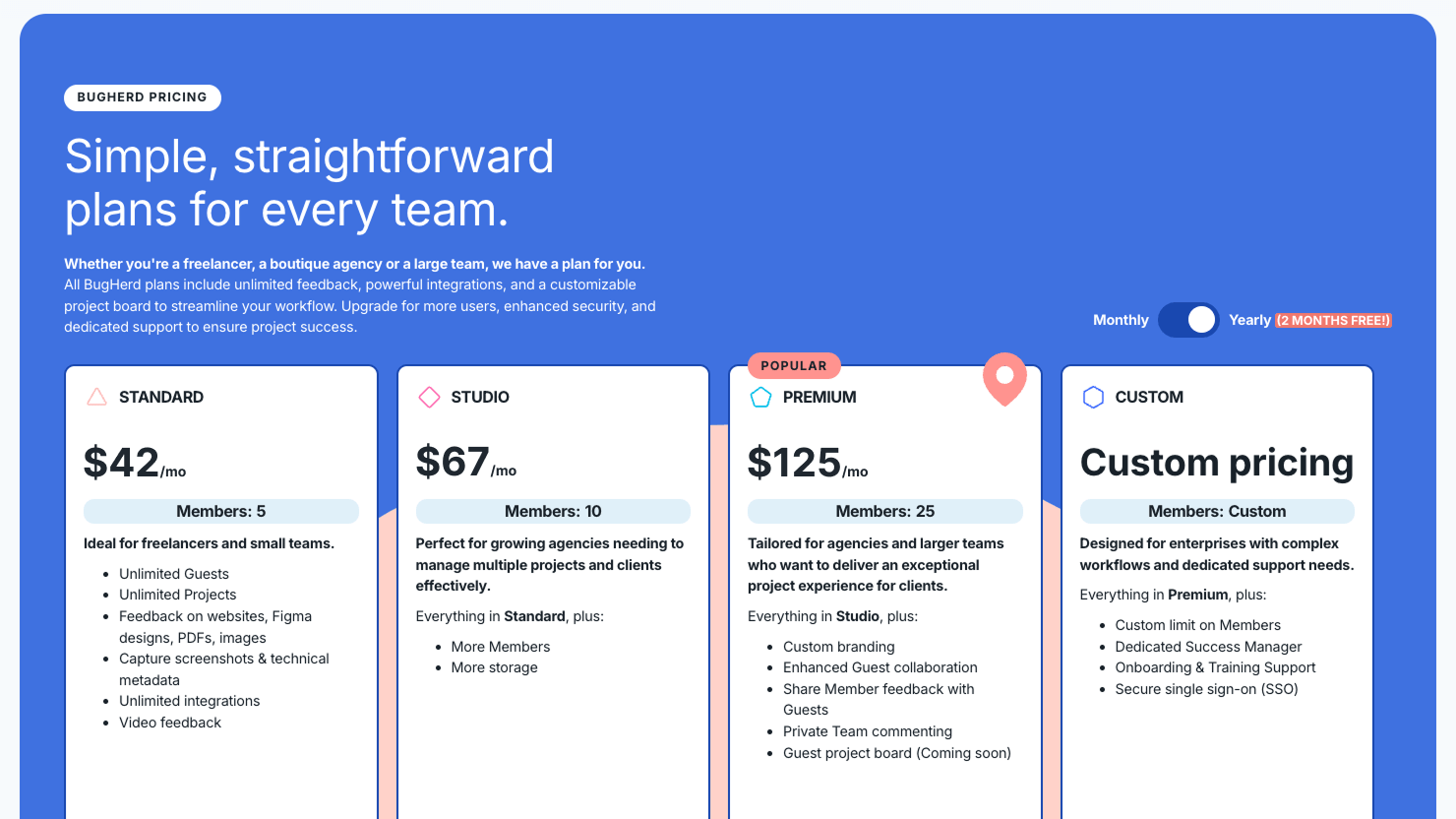



With BugHerd, bug tracking is easy!
Clients simply point, click and comment - BugHerd grabs a screenshot, saves technical details and creates a task for your team to track.








BugHerd is the world's leading website feedback and bug tracking tool that makes it easy for clients to leave feedback and bug reports on websites. Unlike most other feedback tools, it's a complete, all-in-one bug tracking solution, perfect for web development teams.
By replacing outdated methods like emails and spreadsheets, BugHerd provides a visual, intuitive platform where users can pin feedback directly onto a webpage.
Trusted by over 10,000 companies and 350,000 users across 172 countries, BugHerd helps teams collect, manage, and act on website feedback faster — streamlining collaboration between clients, designers, developers, and all other stakeholders.
Forget about long email threads or confusing spreadsheets. With BugHerd, your clients and your team can simply click and comment directly on a web page as they review it, ensuring precise feedback on design, functionality, and content.
BugHerd captures a screenshot or video with each pin left on the website, plus technical details, like browser, operating system, exact URL and more. All the data you need to resolve bugs and feedback fast.
BugHerd’s integrated Kanban board transforms client feedback on websites into trackable tasks. Assign tasks to your team, prioritize issues, and track them to completion. BugHerd lets you easily manage website feedback, from one central location.



BugHerd
✅
Marker.io
✅
Usersnap
✅
MarkUp.io
✅
Ruttl
✅
MarkUp Hero
✅
BugHerd
✅
Marker.io
✅
Usersnap
not PDFs
MarkUp.io
✅
Ruttl
✅
MarkUp Hero
✅
BugHerd
✅
Marker.io
❌
Usersnap
❌
MarkUp.io
❌
Ruttl
❌
MarkUp Hero
❌
BugHerd
✅
Marker.io
❌
Usersnap
✅
MarkUp.io
❌
Ruttl
✅
MarkUp Hero
✅
BugHerd
✅
Marker.io
✅
Usersnap
✅
MarkUp.io
❌
Ruttl
❌
MarkUp Hero
❌
BugHerd
✅
Marker.io
❌
Usersnap
❌
MarkUp.io
❌
Ruttl
✅
MarkUp Hero
❌
BugHerd
✅
Marker.io
❌
Usersnap
❌
MarkUp.io
❌
Ruttl
✅
MarkUp Hero
❌
BugHerd
✅
Marker.io
✅
Usersnap
✅
MarkUp.io
✅
Ruttl
✅
MarkUp Hero
✅
BugHerd
✅
Marker.io
❌
Usersnap
✅
MarkUp.io
limited
Ruttl
✅
MarkUp Hero
❌
BugHerd
✅
Marker.io
✅
Usersnap
✅
MarkUp.io
✅
Ruttl
✅
MarkUp Hero
✅
BugHerd
✅
Marker.io
❌
Usersnap
❌
MarkUp.io
❌
Ruttl
❌
MarkUp Hero
❌
BugHerd
✅
Marker.io
❌
Usersnap
❌
MarkUp.io
✅
Ruttl
✅
MarkUp Hero
✅
BugHerd
✅
Marker.io
❌
Usersnap
❌
MarkUp.io
❌
Ruttl
❌
MarkUp Hero
❌
Easy to use, easy to install. BugHerd can be installed on your website with either a browser extension or javascript code.

It's a fool-proof way to leave valuable feedback and point out website issues without having to deal with complicated defect tracking tools. The user interface is intuitive and leaving feedback is quick and easy.
It's an end-to-end website project management software that makes collecting and managing feedback on designs and websites simple, saving hours of wasted time in follow ups.

It's an efficient bug tracking tool that makes it easy to collect and resolve bug reports, because user feedback is contextual and all the technical data is captured automatically.
BugHerd collects website feedback, complete with a screenshot, annotation and metadata. Website feedback that's ready for the team to action, even from non-technical folk.
While other bug reporters may require different applications to manage the website feedback, BugHerd offers an all-in-one solution. Website and software bugs are sent directly into BugHerd’s Task Board, a kanban-like environment for design and development teams to manage and act on the website feedback.
Take a look at the list of the frequently asked questions (right) to get to know BugHerd better.


But don't just take our word for it.
Customers love us.
4.8/5
4.7/5
4.5/5
5/5
8.7/10
Sam Duncan 📱📏 🌱
@SamWPaquet
"@bugherd where have you been all my life??
We just migrated our bug tracking over from Asana and have at least halved our software testing time🪳👏📈. "
Ashley Groenveld
Project Manager
“I use BugHerd all day every day. It has sped up our implementation tenfold.”
Sasha Shevelev
Webcoda Co-founder
"Before Bugherd, clients would try to send screenshots with scribbles we couldn't decipher or dozens of emails with issues we were often unable to recreate."
Mark B
Developer
“A no-brainer purchase for any agency or development team.”
Kate L
Director of Operations
"Vital tool for our digital marketing agency.”
Paul Tegall
Delivery Manager
"Loving BugHerd! It's making collecting feedback from non-tech users so much easier."
Daniel Billingham
Senior Product Designer
“The ideal feedback and collaboration tool that supports the needs of clients, designers, project managers, and developers.”
Chris S
CEO & Creative Director
“Our clients LOVE it”
Emily VonSydow
Web Development Director
“BugHerd probably saves us
at least 3-4hrs per week.”